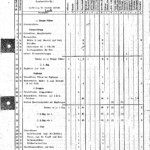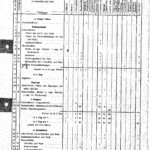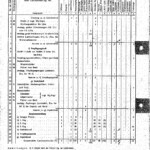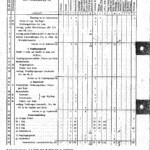We have previously posted an overview of the Wehrmacht unit organizational charts, the KStN. In this overview we looked at the KStN for a Landesschützen-Kompanie. In this article we will look more deeply at the different structures for Landesschützen units in the occupied territories and compare that with the organization of these units inside the Reich.
The April 1942 KStN 4031 for a Landesschützen Kompanie in the “Heimatkriegsgebiet” (Home Front, within the Reich borders) can be found on the WWII Day by Day web site. There were five basic components to the Kompanie, namely a command element, three platoons, and a support element. The Kompanie was commanded by an officer equipped with a bicycle and a pistol. Working for him in the Kompanietrupp were the Hauptfeldwebel, also armed with a pistol, and a staff consisting of 5 messengers on bicycles and 2 clerks. The messengers and clerks were armed with rifles.
The three platoons in the Kompanie were identical. The platoon leader, like the Kompanie commander, had a bicycle and a pistol. He had a staff consisting of a Zugtrupp leader with a rifle, and four messengers, of whom one had a signal trumpet. The messengers were armed with rifles and two of the four had bicycles. There were four squads in each platoon, each with ten men. Each squad was led by a squad leader armed with a rifle. One of the squads had a machine gun team. The machine gun gunner and assistant gunner carried pistols in addition to the machine gun and ammunition, and had a hand cart for the gun. All of the other squad members carried rifles, meaning that in two of three squads, all 10 men carried a rifle.
The Kompanie support and logistics component was the Tross. This consisted of an NCO acting as paymaster, and an NCO in charge of equipment, both armed with rifles. The paymaster had a bicycle. There was also an NCO in charge of clothing, he had no weapon. The Tross also had a wagon drawn by two horses, which was driven by a two-man team, both with rifles.
In our previous KSTN article we looked at this organizational structure for a Landesschützen unit in the occupied West. Let’s look at this again and contrast it with the home front unit described above.
This is KStN 4033, from February 1941. The change in the command element is the presence of a car for the commander, as well as a driver armed with a rifle. There was also initially a horse for the commander, and a person tasked with caring for the horse. In 1943 the horse and caretaker were deleted. The structure of the platoons were exactly the same as described above, with a single machine gun team among the 4 squads. The big changes were in the support element. These units in the occupied territories had to be equipped for field operations if needed. As a result, there had to be a field kitchen, and an enlisted man to cook, with an NCO supervising. There were carts for rations and for luggage, and two horses for each of these carts, with another two horses for the field kitchen. Units that already were equipped with trucks were authorized to keep these. There was a driver for the truck, with the equipment NCO serving as co-driver. 3 enlisted men were tasked with driving the horses. There was also a medical NCO with a bicycle. He carried a pistol. All of the other members of the Tross had rifles.
Here is KStN 4034 from February 1941. This is for a Landesschützen-Kompanie in the occupied East.
These units were at times tasked with occupying large areas and were threatened by partisan activity and enemy breakthroughs. There were a number of changes that reflected this reality. The command element consisted of the Kompanie commander, mounted on a horse, as well as three NCOs- the leader of the Kompanietrupp, a vehicle NCO and an equipment NCO. There were four enlisted messengers, one with a signal trumpet and one who operated a signaling light apparatus. There was a car for the troop, a driver for the car, two cyclists, and a caretaker for the horse. With the exception of the Kompanie commander, who had a pistol, all of these men were armed with rifles.
As before, there were three platoons. Each platoon had a Zugtrupp with one NCO, armed with a pistol, and 3 enlisted messengers, one with a trumpet and one to operate the light signaling system. Each of the four 10-man squads had a leader armed with a rifle. Now, all of the squads had machine guns. The gunner and assistant gunner carried pistols.
The severe logistical challenges faced by units operating in the vastness of the Soviet Union necessitated an expanded support element. The Tross was now three different parts: the Gefechtstross (combat Tross), Verpflegungstross (rations Tross) and Gepäcktross (baggage Tross). The Gefechtstross was led by the Hauptfeldwebel, who had a bicycle. There was a light truck, a combat cart with two horses, and a field kitchen with two horses. The only other NCO was the medical NCO, with a bicycle. Enlisted men served as a clerk (with a bicycle), 4 stretcher bearers, a vehicle driver and a co-driver, 2 drivers for the horses, a weapons NCO assistant, and 2 cooks. The Verpflegungstross was led by the rations NCO, with a bicycle, and had a cart with two horses. Enlisted personnel drove the horses and accompanied the cart. The Gepäcktross was led by the paymaster, again with a bicycle, and there was a cart with two horses for the baggage. There were 2 drivers for the horses, as well as a tailor and a cobbler, all enlisted ranks.
It’s interesting to see the ways that the standard Landesschützen structure was adapted for increasingly challenging deployments. These troops were assigned a huge range of duties.





